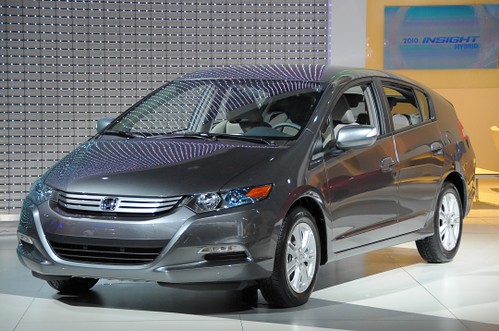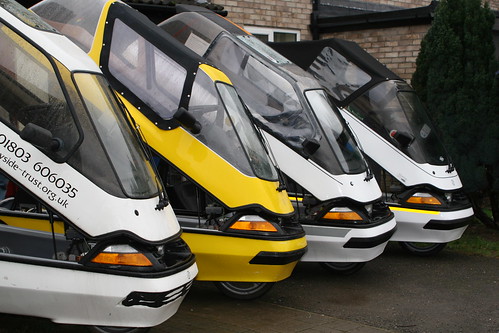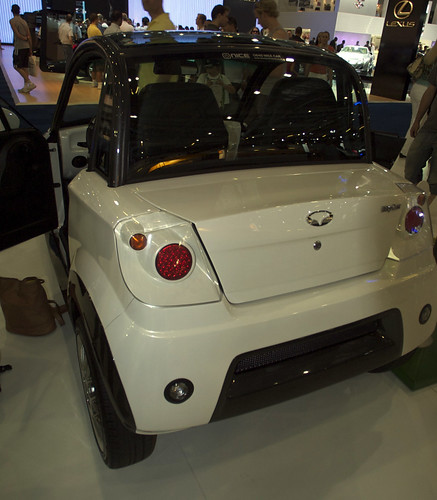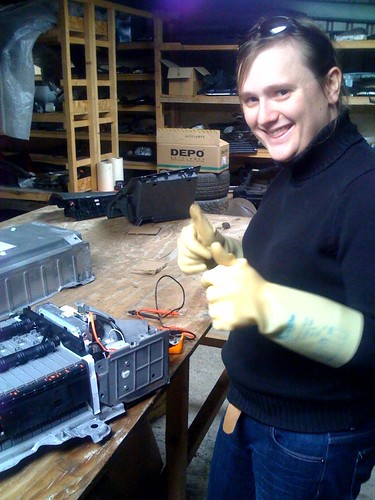Last week at the 2009 SAE World Congress the final plans were bashed out for a new way to charge plug in vehicles. Sadly it’s not an inductive one like the oh-so-simple charge paddles which were used on cars like the EV1 and RAV4EV to name but a few. No, this new standard is a good old-fashioned mechanical plug. You plug your car in and up to 30 Amps at either 120 or 240V flows into your car. Neat.
The latest version of the charging standard, called J1772, will include a five prong plug, capable of allowing communication between the external charger and the car charging. The Volt is rumored to be using it and Tesla have already signed up to make it standard on their cars. But it’ll only be used in the USA. Europe, in it’s own special way, has gone a different route, with a three-prong design capable of up to 80Amps at 240V. Unfortunately, the European standard is three-phase, meaning that it is unlikely to work in most European domestic situations without a complete home re-wire.

Fast charging is great, but does this spell the end for the DIY converter, or those of us who already drive cars with standard domestic plugs? And when you scratch the surface we risk looking at a future where charging plugs are far from standard. With the European standard and US standard finalized, are car companies now going to play nice and only ever use one of two EV charging plugs. What about cross-continent imports? And will those of us with cars now be able to retrofit our cars?
Identity Crisis?
Given the nice weather we’ve been having here in the UK for the past few days I thought I’d take advantage of some rare spare time and head to the local Honda garage today to see if I could test-drive the new Honda Insight. I went incognito, sans camera, to see if I could get a real feel for how the dealership, and the Insight, performed.  What I found was a very fuel efficient car with a confused soul. Somewhere between drawing board and final model, the new Insight feels like a car unsure of what it really is. I’m quite sure it will find a market, but it feels like Honda have tried so hard to please everyone that they’ve managed to produce a car which doesn’t please anyone.
What I found was a very fuel efficient car with a confused soul. Somewhere between drawing board and final model, the new Insight feels like a car unsure of what it really is. I’m quite sure it will find a market, but it feels like Honda have tried so hard to please everyone that they’ve managed to produce a car which doesn’t please anyone.
Is 12 miles enough?
Earlier this week, various reports surfaced detailing Toyota’s plans to release the 2010 Prius as PHEV, but only to fleet customers. The range? A shade over 12 miles (20 km).
While it’s good to see Toyota going towards a Plug in Prius, it’s a little frustrating to see a small PHEV range when compared to the commercial and DIY conversion options out there for the current Prius. It’s also a little frustrating to see that Toyota only plans to sell the PHEV prius to fleets rather than individuals. Is that the right choice? And is 12 miles EV only range enough?

Photo by Swimfinfan, reproduced under creative commons license.
Sorry. No post today
Could falling speed limits in UK help town EVs?
Those red-blooded, meat-eating petrol-heads aren’t going to like today’s motoring news from the UK; The Government is planning to reduce the speed limit of some UK roads to help reduce fatal crashes, improve fuel economy for drivers and reduce pollution. The reductions? The national limit on single-lane (one lane in each direction) roads could be lowered from 60mph to 50mph in rural locations – and the normal town speed limit of 30mph in built-up areas could be reduced to 20mph.
According to this times article, local councils wishing to keep the current speed limits would have to make some seriously impressive cases to be allowed to keep the current 60mph and 30 mph limits. There’s no plans to reduce the speed limit on major roads such as dual carriageways and motorways. That will stay at 70mph.
The idea behind it all of course is to make roads safer and reduce death and serious injury in the next ten years by a substantial amount. Will it be obeyed? Or will it just mean more fines for unfortunate drivers caught out by confusing (and changing) speed limits?
Or is there another effect of this announcement which some of us may actually benefit from in other ways?

Photo by John Honniball
As featured on…
A Japanese Rav4EV appears on UK ebay… What?
Nice Car Split. MEGA take over. MyCar goes elsewhere.
This one happened a while ago, but I didn’t actually get a chance to post about it until today, when I put two and two together to make six.
Until the end of 2008 the Nice Car Company were viewed by many as the rivals to Goingreen, the UK agent for the funny little Indian electric car, the Reva (or G-Wiz, as it’s known here).
The Nice Car company had a very nice showroom and office in the western side of the Capital, and had some pretty nice cars too. Okay. I can’t keep up this NIce talk. I’ll just stop being silly and carry on as normal now. I promise.
Anyway, back to the story. The Nice Car Company not only were the agents for the MEGA Truck and MEGA City, (which many people affectionately called the “Nice car”) but also sold Vectrix electric Motorbikes. At last year’s London Motor show the Nice Car Company launched a whole range of EVs, including an impressive conversion of a Fiat 500 which they planned to lease to customers rather than sell. They also planned to sell the MyCar, which Nice Car Company Founder, Julian Wilford, assured me I would just go crazy for. On arriving at the motorshow last year I had to admit to him that, after looking at it, I’d rather have owned the original Mega City. It just looked more conventional and I’d test-driven one a year or so earlier (and liked it). I liked it better than the MyCar. But at least others did hail the MyCar as the latest in EV must-have. The Nice Car Company were also showcasing an MPV style vehicle, the Zeo, which I quite liked the look of. It was touted to do 50 mph+ and a decent range too. It would have made an ideal vehicle to replace my City El with (before I decided on a plug in prius, that is). Heck, it’d still be better than a plug in Prius if I could have actually owned one – as I would never have had to fill up with fuel, but I digress. Take a look at some MyCar butt.

Photo by Nikki Bloomfield, www.aminorjourney.com
What does this have to do with a company who went bust in December, after sales reportedly went below one car per week? Well, it appears that both the Nice Car company is back up and running but also that the co-founder of the company has gone to pastures new, and taken his MyCar with him…
Top Ten PHEV conversion and information sites.
Earlier on this week I ran an article detailing ten top DIY conversion links. I decided that perhaps it’d be nice to detail ten top PHEV sites for anyone interested in plugging their hybrid in. Unlike the EV conversion scene many plug in hybrid conversions are commercially done, partly due to the expense of battery packs and the demographic of the owners wanting conversions. However, it’s possible to convert a vehicle (existing hybrid or a regular engined car) to a plug in hybrid yourself. You just have to know where to look for help and ideas. Hopefully this list will help.
It is possible to convert a regular gas-powered car to a plug in hybrid too – so don’t think this list is exclusively for those Prius owners. While plug in hybrids aren’t anything new (the first one was back in the early 1900s) we’re certainly at a point where plug in hybrids are starting to enjoy a bit of a golden age. At least, I think that’s where we’re heading. I don’t think we can get to full electrics without at least a passing time of plug in hybrid popularity. I hope that in a few years’ time my list will need redoing as more and more conversion and PHEV options become available.

After the jump are my top ten sites for PHEV DIY converters to look at. Most of them are Prius-based, but by no means are they all so. There’s some other plug in hybrids too. Some of the sites won’t give you much information and others may need a few revisits. I hope you enjoy them all.
It’s nice to have the support, but why not convert too?
Today’s post has been rattling around in my head for the past week or so after a couple of comments to previous posts I’d made really got me thinking along with some really intense discussions with various EVers this week. Big thanks to Joe Lado, my good friend Pyoor Kate and Andrew Bissell for getting me thinking. What about? Well, about the future of plug-ins in the UK.
See, it’s long been my thought that EV conversions have to play a part in the future of plug in vehicles. How else are we going to get the 33 million or more vehicles on the roads of the UK switched to greener fuels? Scrapping them all isn’t an option. At £2,000 per pop, (in a scheme similar to those held in Germany and Ireland) I simply don’t see the money being there. Someone would have to fund it. As Pyoor Kate put it when I chatted to her earlier today, £2,000 to force coerce people into scrapping working vehicles to switch to newer vehicles may be a great idea on the face of it, but what if those vehicles don’t need replacing. What if they’re mechanically pretty sound?

Photo by Ekai
Details of a better deal for encouraging EV and PHEV takeup after the jump